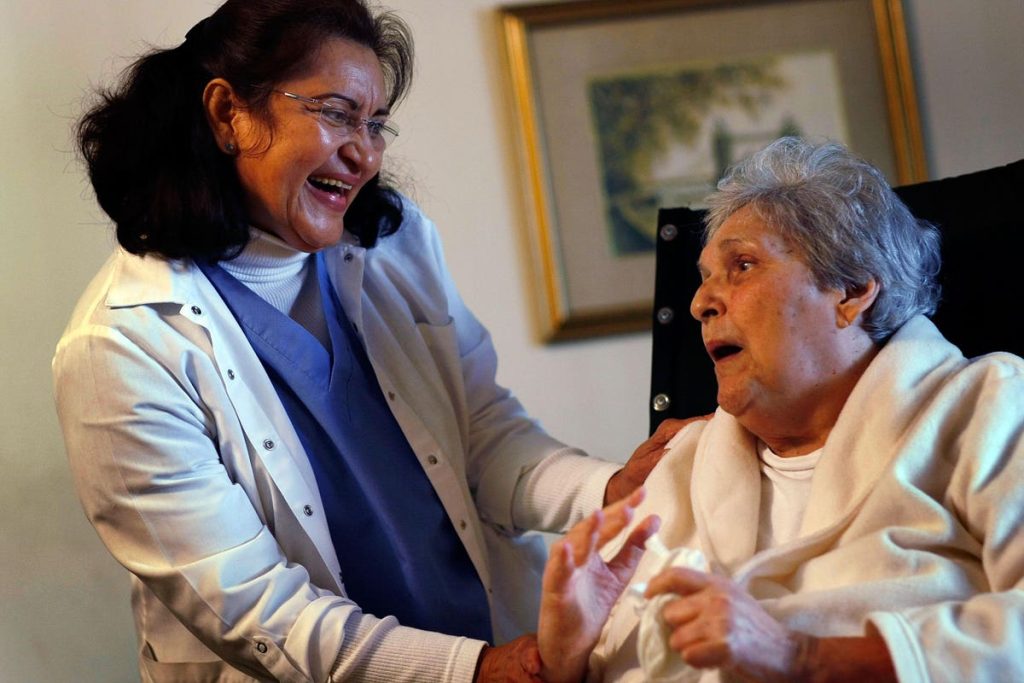The federal Centers for Medicare and Medicaid Services (CMS) has moved to increase pay for home care aides and others who provide personal care for frail older adults and younger people with disabilities. It has proposed new rules requiring Medicaid home care agencies to direct at least 80 percent of program payments for personal care services to compensation for care workers. In effect, more money would go to workers and less to administrative overhead and profit.
Since his campaign for president, Joe Biden has been pushing to boost wages and working conditions for direct care workers, including certified nursing assistants in nursing homes and home care workers. The new CMS proposal is one step in that direction and the agency will soon mandate new minimum staffing for nursing home care workers.
The new rule would apply to personal care workers, homemakers, and home health aides. But it affects only Medicaid home and community-based (HCBS) long-term care services. It does not apply to Medicare home health.
An Important Boost
Already, 22 states have moved to direct more Medicaid payments to care workers. Some require providers to pay a minimum dollar amount to direct care staff. CMS would follow a different model that requires firms to dedicate a fixed percentage of Medicaid payments to care workers.
The move could provide an important boost to their hourly wages, which currently average only about $14.15, according to the Bureau of Labor Statistics. About one of every seven direct care workers lives in poverty and one-third are on Medicaid themselves.
However, we know very little about whether these efforts by the government to manage wages materially benefit home care aides. And the story may not be simple.
Unintended Consequences
Government attempts to put a floor on wages often produce unintended consequences. It will be a special challenge with these rules because little new money is being added to the Medicaid system.
While Congress approved a short-term boost in federal Medicaid HCBS payments in 2021, it has been unwilling to increase future federal contributions. At the same time, many states have been slow to boost payments for Medicaid HCBS. During the pandemic many states approved temporary bonuses for Medicaid care workers but those rarely were built into their wage base.
Without more money in the system, will the new rule discourage more home care providers from even accepting Medicaid beneficiaries? Access to Medicaid agencies already can be a problem. While nearly all agencies accept Medicare, only about three-quarters took Medicaid in 2016.
Since then, many states have moved to a Medicaid managed care model and about 70 percent of beneficiaries now are covered by these plans. These states pay managed care organizations a fixed monthly rate for providing all care to their Medicaid beneficiaries. The insurers, in turn, contract with home care agencies and other providers for services, often paying less in exchange for delivering increased volumes of patients.
But many of the highest-quality agencies already serve only the lucrative private-pay market and refuse to accept Medicaid clients. This new rule could worsen that problem, which perversely could further limit the supply of home care workers for Medicaid beneficiaries.
A related problem: When Medicaid aides are paid more, private pay prices may rise as well, both for agency aides and the so-called gray market. That would be good for workers. But it could make care even less affordable for millions of families who are ineligible for Medicaid but don’t have the resources to pay for assistance. Higher compensation for personal care aides may force them to reduce hours of paid help.
At the same time, some unscrupulous home care agencies will surely find ways to game the new system. They always do.
Is The Market Adjusting?
Finally, the market already may be beginning to adjust wages. Pay for both home care workers and facility-based aides appears to be rising, since the supply of willing workers remains well below what it was before the pandemic.
While today’s average hourly wage of $14.15 still leaves many home care workers living in poverty, it is about 10 percent higher than the $12.98 average in 2020. And, anecdotally, both home care and facility-based providers report having to pay even higher wages.
At one small non-profit facility in rural Maine, staff members told management they were considering leaving because other local businesses, including a sandwich shop and even the town dump, paid more. As a result, the facility raised direct care hourly wages last Fall by 14.5 percent to an average of $18.25, even though it had to dip into reserves to do it.
The market is sending a clear signal: If we want enough care workers to assist a rapidly growing population of frail older adults and younger people with disabilities, we are going to have to pay them more and treat them better. But it remains to be seen how well government mandates will achieve those goals.
Read the full article here
